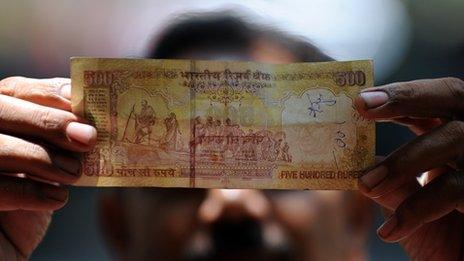Six reasons why India's rupee is in freefall
- Published

Domestic and international issues have hurt the Indian currency in recent months
Since July last year, the Indian rupee has fallen by more than 27% against the US dollar, one of the biggest declines among Asian currencies.
Here are six main reasons for the steady slump in the value of India's currency:
HUGE TRADE DEFICIT
Since India imports more goods (in value terms) than it exports, it results in a huge imbalance in trade, or what is called a trade deficit.
In the financial year ending March 2012, the deficit zoomed to $185bn (£118bn) compared with the original estimate of $160bn.
India's Commerce Secretary Rahul Khullar has predicted that the trade deficit may be slightly lower in 2012-13, due to falling global crude prices and recent government curbs on gold imports.
A $1 per barrel decrease in crude price reduces the country's deficit by $900m at existing import volumes.
On the flip side, India's export performance may prove to be a dampener this year.
Mr Khullar has added that India will be lucky if exports, which grew 21% in 2011-12, manage to witness a growth rate of 10-15% in 2012-13, due to the crisis in Europe and slow economic recovery in the US.
LOWER CAPITAL INFLOWS
Although India has become an attractive destination which can woo foreign capital as well as money from non-resident citizens, it is not enough to make up for the trade deficit.
In 2011-12, India received foreign direct investment of more than $30bn, in addition to a net inflow of $18bn from foreign institutional investors in stocks and bonds.
But uncertainty about India's commitment to economic reforms, retrospective taxes, and policy paralysis within the government have forced foreigners to either postpone their investment decisions, or take money out of Indian stock markets.
HIGH CURRENT ACCOUNT DEFICIT
The country's current account deficit - a broader measure of the trade deficit - has also ballooned due to the above reasons.
In 2011-12, this deficit was more than $74bn, a huge jump from less than $46bn a year ago. In 2012-13, it may be even higher at $77bn.
The result is that India's foreign exchange reserves have dropped from a peak of $320bn in September 2011 to $290bn now.
DEVALUATION PRESSURE
In such a situation, more people tend to sell rupees to buy dollars (or any other foreign currency that they require).
Importers scamper for dollars to cater for their needs to buy goods abroad.
Exporters cannot bring in enough dollars; in fact, they keep their foreign earnings abroad as they expect the rupee to fall further.
Meanwhile, foreign investors increase the demand for dollars as they convert their rupee assets into dollars to take their money out.
This demand-supply gap between the dollar and the rupee leads to devaluation.
LOW GROWTH AND HIGH INFLATION
This trend is accentuated by low growth and high inflation in India.
After annual economic growth of nearly 9% in 2009-10 and 2010-11, the country is likely to grow at 6.5% in 2011-12.
The expectations for 2012-13 are not too encouraging.
Couple this with high inflation due to high food and fuel prices. The rate of inflation may rise this year to double digits if the government is unable to curb its fiscal deficit.
In this scenario, most foreigners as well as Indians tend to take money abroad, or keep it away from India.
Global investors are also nervous about investing abroad in nations such as India due to the economic crisis in their respective countries.
That has added further selling pressure on the rupee.
RUPEE SPECULATION
The Reserve Bank of India's bid to sell dollars in the open market to restrict the rupee slide has failed in the past few weeks and months.
This has complicated the situation further.
Once currency traders and speculators realise that India's central bank is unable to manage its exchange rate, and reduce the adverse impact on its currency, they may enter the market in a big way to sell the rupee.
As a result, the rupee may devalue more than it should.
Experts, who a few weeks ago predicted that the Indian currency might stabilise at 55 rupees to the dollar, now say this may happen at 60 rupees.
- Published23 May 2012
- Published16 May 2012
- Published10 May 2012